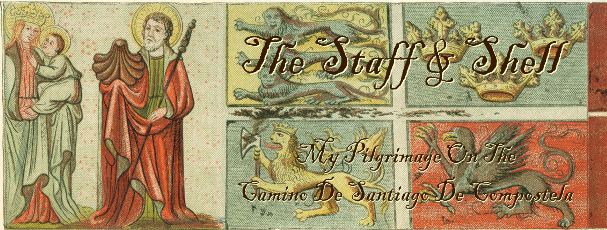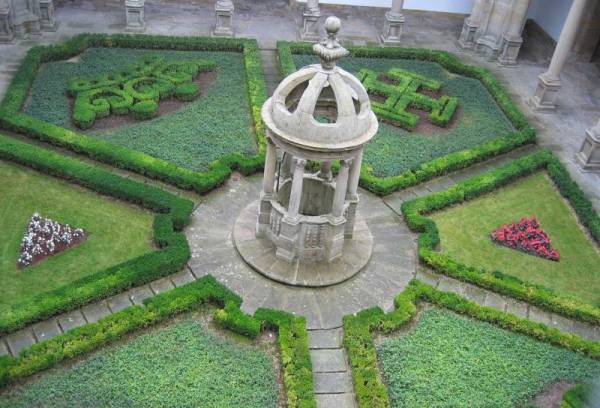
WHO BOOKED FOR SANTIAGO
During the Middle Ages, most pilgrims made the trip to Santiago hoping to improve their standing with God, which might then result in the miraculous cure of an illness or salvation in the afterlife. But a pilgrimage had to include some suffering. Suffering echoed the passion of Christ and improved your chances for a successful trip.
Even today there is a fair amount of suffering on the road, nothing like the Middle Ages but still significant. And some people believed that the kind of physical pain you suffer during your pilgrimage is related to your mental state. Pain in your back or shoulder comes from emotional stress. Leg pains are the result of relationship problems. Lower back pain is thought to come from too much responsibility or too many commitments.
A pilgrimage might be based on the desire for a more spiritual life or it might be in atonement for previous sins. During the 12th century, a criminal might be required to make the pilgrimage to Santiago as part of his punishment. Murders were often required to make the pilgrimage to Santiago with the murder weapon hanging from their body so everyone could identify both the criminal and the crime. Today the head of a corporation that defrauded its shareholders might make the trip dragging his annual reports or the body of his accountant.
BONUS MILES
The Road to Santiago is actually a series of connecting roads that have been in use since Roman times. The Irish and the English came by boat and arrived at La Coruna just north of Santiago. The Portuguese walk straight up along the coast. The Silver Road brought pilgrims from central and southern Spain.
But the busiest route was the French Road. Perhaps the French had more sins that needed to be forgiven. Actually, that’s not a fair comment, the French Road also brought pilgrims from Germany, Scandinavia, the Netherlands, even Italy. It was open to all sinners regardless of their race, creed or previous position of servitude.
Each of the four roads that went through France started in big cities like Paris or Arles - then crossed the country until they all came together at the foot of the Pyrenees Mountains that form France’s border with Spain. At that point they merged into one road that passed through the mountains and crossed northern Spain until it arrived at Santiago de Compostela.
The routes in France and across Spain were highly developed. They offered pilgrims places to rest, and recover. And all along the roads monasteries and churches promoted the journey.
The pilgrimage to Santiago was a major commercial enterprise. Important churches along the route would travel their relics throughout Europe to advertise the trip and raise money for the maintenance and expansion of their buildings.
There were abuses but the majority of clerics involved respected the religious devotion of the pilgrims and spent enormous amounts or money feeding and housing the poorer travelers.
In addition, many townspeople along the roads helped the pilgrims in exchange for the pilgrims offering prayers on their behalf in Santiago.
Wealthy pilgrims were expected to pave the road with donations. During the Middle Ages a team of laborers worked through the day gathering up the gold and silver offerings that had been left by the altar along with the donations of cows, sheep, pigs and horses.
PROTECTOR OF THE FAITH
In the year 711, Islamic Moors from North Africa invaded the Iberian Peninsula and occupied parts of it until the end of the 1400, a period that lasted over 700 years. Christians in other parts of Europe were determined to take Spain back and their first successful battle in the Reconquest took place in 844.
Just prior to the battle King Ramiro I had a dream in which Saint James appeared and announced that he would join the battle carrying a white flag, riding a white horse and brandishing a great shining sword and that he would help Ramiro win the battle.
Ramiro did win the battle and Saint James took on the roll of the slayer of Moors. The belief that Saint James was present at each of the important battles was an essential element in the Reconquest of Spain. Saint James ended up with three images:
St. James as the Apostle, St. James as a pilgrim heading to his own shrine, and St. James on horseback as the slayer of Moors.
And these days, he is returning in his role as an agent of reunification.
In Europe, World War II was a demonstration on a mass scale of man’s inhumanity to man and it left the continent broken and fractured. The late 1940s marked the beginning of a search for a politically united Europe through its shared past. The Road to Santiago, with its historic roots throughout Europe provided an ideal way to overcome political differences. It was also a time where middle-class Europeans began to travel. The pilgrimage was no longer solely for the religious traveler, it became a more general journey for people in search of personal and social goals.
The Spanish government saw the light and began promoting the road as an alternative to mass tourism and the apparent superficiality of sitting on a crowded beach. Once again Santiago became a symbol for enlightenment and reunification.












































